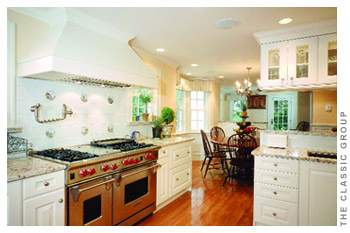Creative Kitchens
Local designers and contractors help Wellesley and Weston homeowners create dream kitchens that reflect their individual lifestyles.
Nicole Goldman writer
Gone are the avocado-toned appliances, the laminate countertops, and, in some cases, the work triangle. Today’s premier home kitchens are an expression of personality, family  lifestyle and excellent design. As the kitchen is often the centerpiece of the home, nearly every family activity takes place there, from cooking and eating to reading and helping with homework, or watching television and paying bills. The floor plans have grown, the square footage has increased, and the kitchen’s functions have expanded in response to busy schedules and demands for convenience, aided by improvements in materials and design.
lifestyle and excellent design. As the kitchen is often the centerpiece of the home, nearly every family activity takes place there, from cooking and eating to reading and helping with homework, or watching television and paying bills. The floor plans have grown, the square footage has increased, and the kitchen’s functions have expanded in response to busy schedules and demands for convenience, aided by improvements in materials and design.
We visited several homes in Wellesley and Weston to see some of the latest ideas and approaches to kitchen remodeling. The decisions these homeowners made were influenced, in part, by professional designers and architects who listened to their client’s hopes and needs, then applied their expertise to design rooms that function well and reflect a way of life. While the end results may vary, the goal for each bears a resemblance: to create a beautiful new center for the home with exceptional design and craftsmanship.
 In the Wellesley home of a young couple, a collection of modern art was the inspiration for a vibrant design. Scandinavian heritage was the impetus for a collection of boldly-colored art throughout the house. The couple wanted to open up a series of smaller rooms to create a large family area that would include an updated kitchen, and adjacent family and entertaining areas.
In the Wellesley home of a young couple, a collection of modern art was the inspiration for a vibrant design. Scandinavian heritage was the impetus for a collection of boldly-colored art throughout the house. The couple wanted to open up a series of smaller rooms to create a large family area that would include an updated kitchen, and adjacent family and entertaining areas.
Dan Tibma, of Tibma Design in Needham, was called in to devise ways that would enhance these aesthetic concerns. Tapping into the company’s expertise with a team of eleven professional designers, he led his clients to the ultimate design decisions, eliciting information on the practical variables that would drive the project. With a plan laid out before them, his clients could better understand where decisions would need to be made.
Since the kitchen and adjoining rooms are often where people spend most of their time, good design and comfort are paramount concerns. Dan’s group took design cues from the couple’s emphasis on their art collection, and its colorful palette. European cabinetry, with its sleek, clean lines, was installed in a light maple wood. Choices in this project were made along aesthetic lines, rather than the merely functional. Steel door handles were added to draw a crisp edge. The blue Silestone® countertops with their high visual impact set the tone for surrounding rooms and their décor.When it came time to select appliances, the Tibma group chose stainless finishes to emphasize the contemporary look. Dan raved about the in-counter steamer, a mechanical multi-tasker that poaches, steams and defrosts. Behind the stove a pot-filler faucet, another increasingly popular and convenient feature, does away with heavy lifting of pots and Dutch ovens. A Best® hood, with a heavy-duty exhaust fan, was installed above the cook top. To minimize the noise it generates, workers installed the motor on the roof of the house. Dan mentioned that he installs many chimney hoods, and those featuring their own exhaust fan and flue are especially useful over larger, commercial-style ranges.
Alterations were made to the work triangle by moving the double ovens away from the central work area. An oven, Dan notes, is something that doesn’t need to be the center of the action. A cook puts things in it, closes the door, and walks away. A convection oven is another appliance to consider, as it is quiet, quick and another multi-tasker.
For a remodeling project in Weston, the homeowner, a professional caterer, had very clear ideas about the kitchen plan and every element she needed for both household and business purposes.
When LDa Architects of Cambridge was brought in, their charge was to expand the size of the home, without altering the feel of the original farmhouse. As in the case of many kitchen-remodeling projects, several other areas of the home were also being upgraded, which added to the options for expansion and design of the main floor where the kitchen would be replaced.
The existing kitchen was a small, dark room at the back of the house. In addition to needing more space for her burgeoning business, the homeowner wanted the room to have a better connection with family activities, and to create an open floor plan to make things brighter and take advantage of expansive views of the backyard which borders on conservation land.
The homeowner wanted condiments close at hand, counter-top appliances, and storage shelves for her impressive collection of cookbooks. Design elements such as a larger space between the island and the stove meant that more than one person could be cooking at the same time. Open shelving surrounding the stove meant that cabinet doors would not interfere with the rapid-fire action of a busy chef. An uncluttered, contemporary feel was desired. Aesthetic considerations were kept simple and practical with Shaker-style cabinets, a subway tile back splash and stainless steel appliances.
Bringing function to the forefront in this project drove the design, but not necessarily all the details. The kitchen’s palette represents a connection with the outdoors, and inspired the soft greens that are used throughout the space – on selected cabinetry, the tiled wall, and the veins of the Kashmir white granite counters. A maple tree that had been cut down in the front yard years before had been salvaged and was milled to create the center island, a thoughtful historic reference to this property. In the end, a desire for a beautiful design within a functional setting resulted in a well-planned space that would encourage family interaction amid the hubbub of a catering business.
A kitchen renovation for another Wellesley family centered on the understanding of the house as a whole. This colonial style home resembled many in the neighboring area, but lacked personality, depth and space. The homeowners were sensitive to limiting the expansion and were intent on avoiding a “MacMansionized” result. While they did need to open up the rear of the house to create new family space, they wanted to keep the house consistent with the style and sizing of the neighboring homes.
The Classic Group, based in Lexington, designs and builds homes with traditional New England styling. When they were called into this Wellesley project, their springboard for the design was developed with historic principles in mind. Dennis Lawlor, a principal of The Classic Group describes their approach as a measured expansion with traditional elements. Architectural details were derived from nearby homes so the house would fit harmoniously with its surroundings. Inside, traditional features such as a formal dining room connected to the kitchen by a new butler’s pantry brought an historically-correct feel to the design.
Created in tandem with Dalia Kitchen Design of The Boston Design Center, the kitchen was expanded only five feet off the back of the house. A variance was required, however, for the new bay window and sunroom, due to zoning regulations. The kitchen layout could then be increased and made more efficient with a new peninsula looking out into the sunroom and keeping the feel open and bright. Overhead cabinetry sustained the traditional look, and offered needed storage for dishes and glassware.
The former, disjointed sunroom was converted into a family room that now flows into the breakfast room and kitchen areas. The previously chopped-up layout has been transformed into a more contemporary plan, that supports the casual activities of the homeowners in the rear of the house but maintains the formal characteristics in the more public front rooms.
Kitchen remodeling is a complex, time-consuming and often expensive undertaking that can be highly satisfying for those who bravely take this road. Working with professional designers and builders, and allowing the time needed for planning, are essential to a successful renovation, and the key to making a home that reflects a way of life that is uniquely your own.
© 2006 Elm Bank Media



recent comments